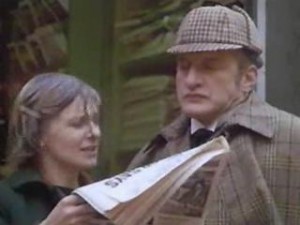The end of the film, with Holmes and Watson alone in New York’s Central Park, is somewhat ambiguous, and the viewer will wonder if Holmes’ much prophesied confrontation with Moriarty is about to come to pass or if the idea, after all, is only in his head.
 Rather soon in the film—certainly long before it’s over—we the viewers have shared the excitement and disappointments of the two characters—and grown fond of them. Their common decency is endearing. Beneath the crusty objectivity, Holmes has revealed a sentimental heart, and almost from her first encounter with her patient, Mildred has enjoyed his company more and more and has come to believe in his world, if ever slowly, ever cautiously. And, too, maybe we, just a little, would like to share their naïve belief in things magical and impracticable.
Rather soon in the film—certainly long before it’s over—we the viewers have shared the excitement and disappointments of the two characters—and grown fond of them. Their common decency is endearing. Beneath the crusty objectivity, Holmes has revealed a sentimental heart, and almost from her first encounter with her patient, Mildred has enjoyed his company more and more and has come to believe in his world, if ever slowly, ever cautiously. And, too, maybe we, just a little, would like to share their naïve belief in things magical and impracticable.
Coauthors Robert W. Pohle, Jr. and Douglas C. Hart in Sherlock Holmes on the Screen (1977) have expressed, far better than I, what might well be the unique achievement of the film:
All in all, Giants must rank as one of the sincerest attempts ever to transfer Sherlock Holmes to the screen, for the film treats this highly complex character with a good deal more respect (and deserved ambiguity) than very many of the so-called “straight” adaptations of the original Doyle stories. . . . [I]t seems that the liberation from slavish convention . . . has allowed the film makers to come closer to the fundamental spirit of the original literary creation . . .